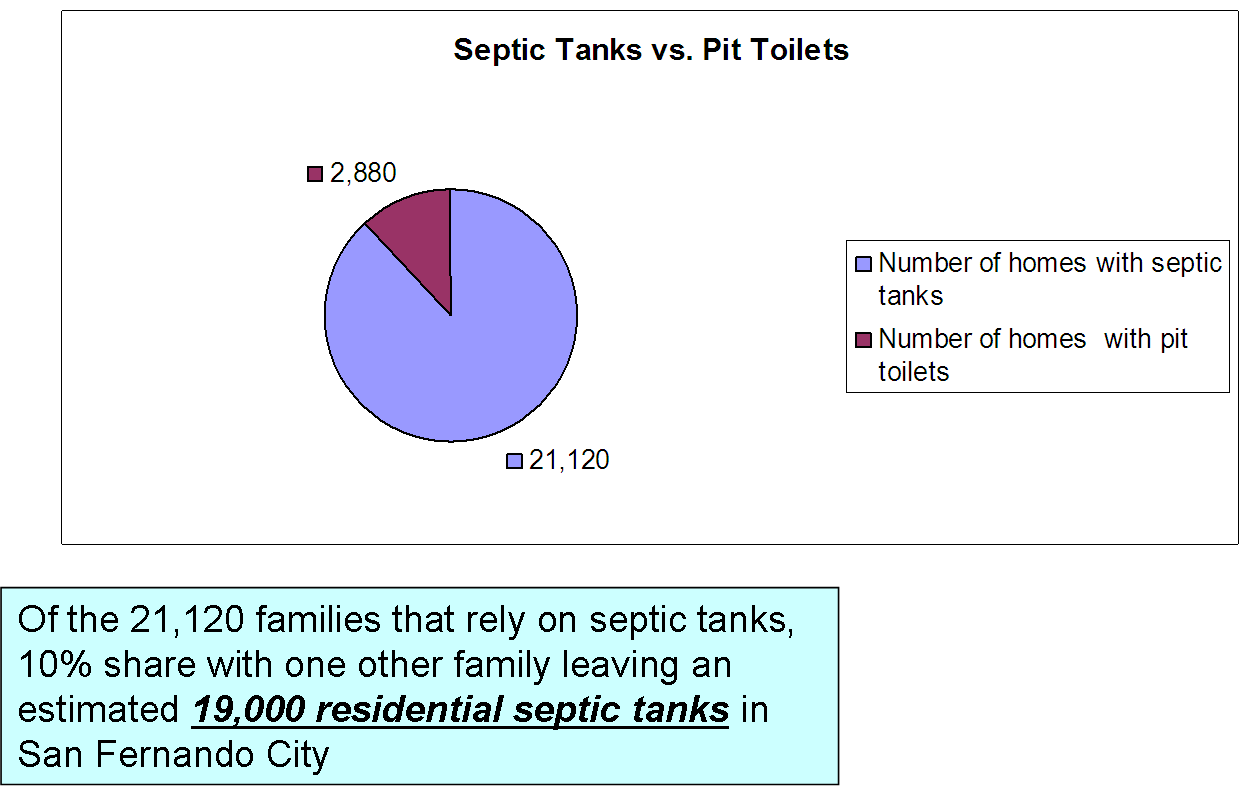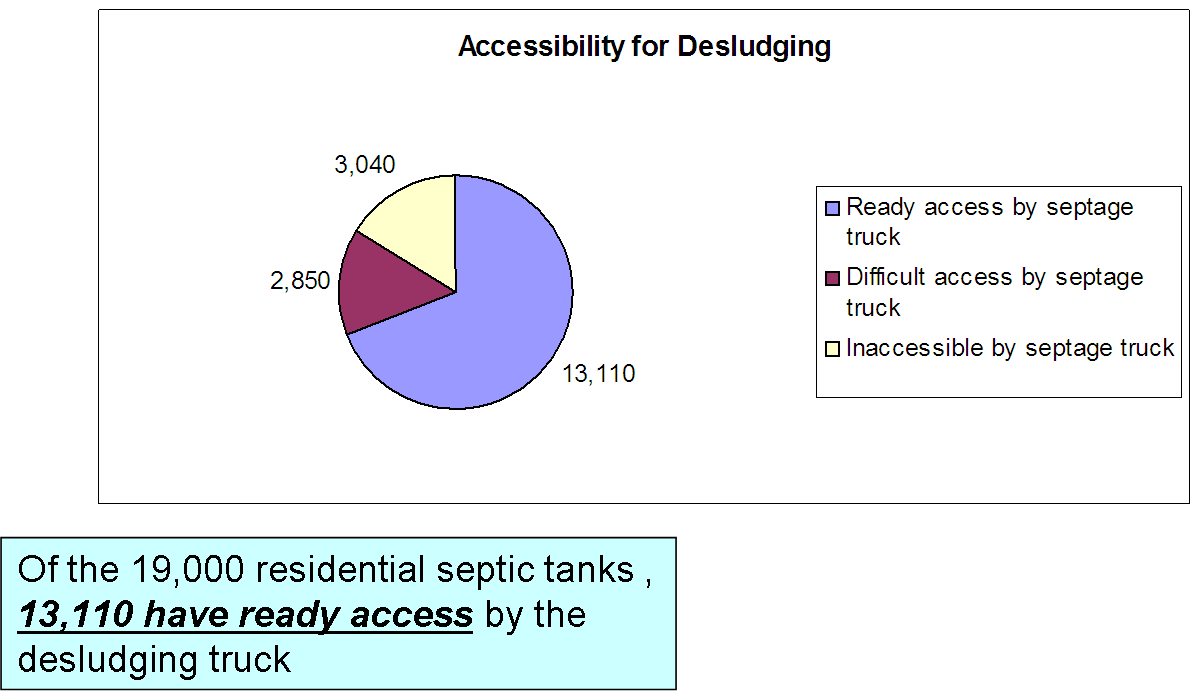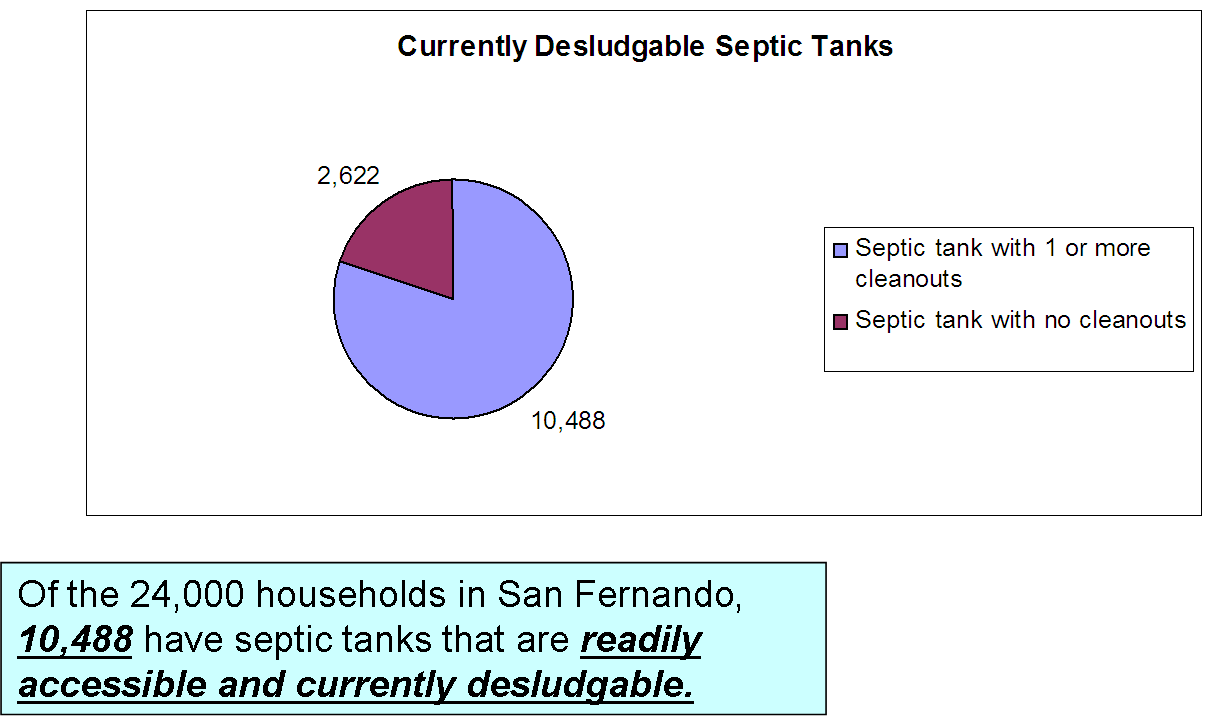San Fernando City - Assessments
In March 2010, barangay health workers along with licensed plumbers and engineers were deployed to 15 barangays to conduct rapid technical assessments in San Fernando City in the Philippines. Teams of three (one health worker, one plumber and one engineer) went to houses to look at the state of wastewater treatment at the household level and to determine the knowledge, attitudes and practices related to sanitation. Below is what they found out:
In order to determine the current state of sanitation in San Fernando City, rapid technical assessments were combined with surveys on knowledge, attitudes and practices for 150 households in 15 barangays. The purposes of the surveys were to evaluate septic tanks and septic tank practices for households that rely on these wastewater treatment devices and to evaluate pit toilets or communal toilets for houses where septic tanks were absent. Information was also gathered on the state of indoor plumbing, greywater discharge and the mechanisms by which wastewater effluent flows away from homes. The results of the assessments and surveys provide the research that will be used to tailor the promotions campaign so that outreach efforts are targeted, meaningful and effective.
Contents
Septic Tanks and Pit Toilets
According to the latest Philippine census, San Fernando City has a population of about 114,800 people in 24,140 households. Of these households, the survey estimates that 88% rely on septic tanks, while 12% utilize pit toilets.
This equates to 21,120 families that utilize septic tanks as their primary wastewater treatment device. The survey also determined that 10% of the families share septic tanks with their neighbors, leaving a total of approximately 19,000 residential septic tanks in the city. This is the baseline starting point for developing the septage management program that will desludge the city's residential septic tanks on a rotating 5 year cycle.
It should be noted that a small number (less than 1%)of families claimed to use communal toilets, and an even smaller number indicated that they had no access to sanitary facilities at all.
Accessibility for Desludging
An important goal of the assessment was to determine the number of residential septic tanks that are accessible by desludging trucks. San Fernando City has many rural and coastal areas that are not easily accessible by car or truck. In addition, it was noted in the survey that some houses are located far off the road, sometimes in excess of the length of a standard desludging truck hose.
The assessors were trained to identify these issues and rate homes as being readily accessible, difficult to access or inaccessible.
The results show that of the 19,000 residential septic tanks, almost 5,900 fall within the categories of being either inaccessible or difficult to access by septage truck. The remainder: 13,110 residential septic tanks that are considered readily accessible.
Septic Tanks and Cleanouts
In the Philippines, septic tanks are often located under the kitchen or comfort room to allow for easy drainage. Unfortunately, in some instances, septic tank cleanouts have been covered by flooring or may have never existed. In still other cases, septic tanks are believed to be present, but the location of the septic tank is not known.
The results of the assessment show that 20% of the septic tanks do not have clean-outs, or if they do, the location of the cleanout was not known.
Interestingly, 30% of septic tanks in San Fernando City have only one cleanout. Proper septic tank practice requires that septic tanks have a minimum of two chambers and that one cleanout be installed over each chamber.
However, for the purposes of determining desludgability, those tanks with a minimum of one cleanout were considered desludgable. When combined with the number of tanks that can be accessed by the truck, the total number of readily accessible and currently desludgable septic tanks is 10,488. This will represent the Phase 1 of the septage collection and treatment program. The remaining tanks will be desludged during subsequent phases.
Other Interesting Survey Results
- 54% of homes with septic tanks discharge their effluent through open channels that lead to off-site surface waters. Open drainage leads to flies, odors and environmental health hazards. These results suggest that a program to promote installing closed pipelines to transport effluent away from the house to off-site drainage could result in significant improvements to environmental health in the barangays.
- 61% of the septic tanks inspected have roof gutters or surface drains discharging to them. This is a condition that can overload the septic tank and cause overflowing. This is an easy fix where a plumber can redirect stormwater flows away from septic tanks. Information in the form of fliers or handouts that describe this problem and provide instructions for correction could be beneficial to homeowners.
- Of the 150 houses inspected, only 9 had greywater flowing to the septic tank. The remainder discharged greywater without treatment. 20% of the houses discharge their greywater to closed drains that discharge off property. 48% discharge their greywater though either open channels that lead to off-site discharge or is simply left to pond near the home. Greywater may contain pathogens and will create nuisances if not properly addressed. An outreach campaign to educate homeowners on proper greywater treatment and reuse suggestions would likely help reduce nuisances from improper wastewater disposal.
- 79% of the respondents have wells on their property. 28% are shallow with static water depth at less than 2 meters below grade. 62% of the total number of wells are located within 25 meters of the house. Since 56 of 59 wells in San Fernando city recently showed high levels of E-coli contamination, and they should be 25 meters away from any septic tank, the data suggests a linkage. An information campaign that promotes adherence to proper septic tank/well setbacks might help alleviate this problem in the long term.
- 12% of the properties inspected have pit toilets, and of those, 46% were vented. Of the total number of pit toilets, one-third of the users of these toilets described nuisance conditions including odors and flies. The results indicate that over 50% of the pit toilets in San Fernando City are unimproved, which may also lead to groundwater pollution. Information and education campaigns on how to upgrade unimproved pit toilets might help control this source of pollution.
- 49% of homes evaluated had no plumbing vent stacks for proper septic tank venting. Additionally, only 50% have proper P-traps. This information suggests that homes that upgrade to proper septic tanks must also correct plumbing deficiencies in the home to avoid nuisances.
- One fifth of the homes are considered newer, having been constructed within the last 10 years. Many of these may have proper two compartment sealed septic tanks. The remaining 80% are older homes with bottomless septic tanks. This situation represents another probable link to the groundwater pollution problem. Educating the public about this issue and requiring proper septic tanks for homes undergoing remodeling or new construction should be promoted.



